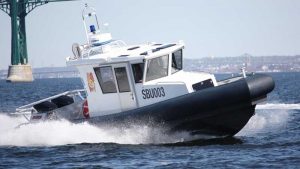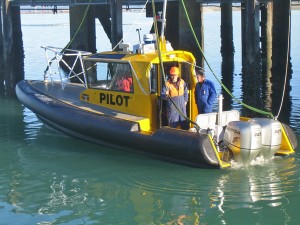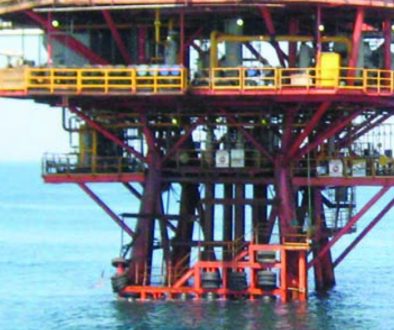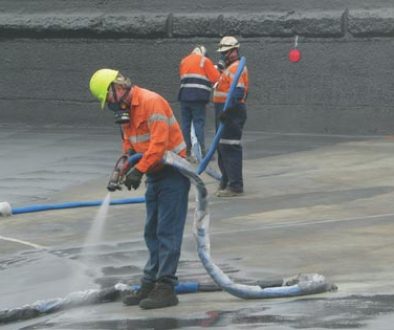Protective Coatings for Rigid Hulled Inflatable Boats
![]()

A Need for Strong Flexible Coatings for Rigid Hulled Inflatable Boats
For a range of activities and operations in the maritime environment, small, maneuverable, robust, stable, high-speed boats are a necessity. Rescue services must respond quickly to emergencies at sea and port authorities need to get harbour pilots to and from ocean-going vessels for safe operation within a port area. Similarly, police and the military, need to pursue vessels that are suspected of being involved in criminal activity and get officers on board quickly and safely.
During the past couple of decades, a range of rigid-hulled inflatable boats (RHIBs) have been built and refined by companies to meet the demands and stresses of all these tasks.
The combination of rigid hull and large inflatable buoyancy tubes was first developed in the 1960s. The early inflatable sections were not very robust and were prone to deflating. Research showed that the strength and durability of the inflatable sections could be dramatically improved by using spray-applied surface coatings to cover the tubes. To be successful, coatings must be strong, flexible and resistant to the ravages of continual exposure to salt water and UV light.
Polyurethane used Successfully to Protect Inflatables
 Polyurethane coatings produced by Gold Coast-based Rhino Linings Australasia (RLA) are used by some RHIB manufacturers to protect and strengthen the inflatable sections, in addition to providing non-slip walkways on deck sections when required.
Polyurethane coatings produced by Gold Coast-based Rhino Linings Australasia (RLA) are used by some RHIB manufacturers to protect and strengthen the inflatable sections, in addition to providing non-slip walkways on deck sections when required.
One versatile surface coating in particular, Rhino TUFF STUFF, provides maximum slip resistance with enhanced protection against impact, abrasion and corrosion. Spray-on application creates a single, seamless coating, that conforms to any shape and size and bonds to virtually any substrates.
Polyurethane coatings made by the company have a patented mix ratio that have been developed over many years. “We have dedicated staff who understand the chemistry of the product,” said Denis Baker, Special Projects Engineer at RLA. “They have a great depth of knowledge and experience for which products can be used and in what situations.”
The elastomeric properties of the Rhino Linings coating systems allow for application to surfaces that are subject to vibration, expansion, contraction, movement, flexing, abrasion and impact. The selected coating in this case is extremely flexible while maintaining its integrity under repeated flexing, regardless of film thickness. “
What is a Rigid Hull Inflatable Boat?
 RHIBs range in size from 4 to 9 metres, although they can be as long as 18 metres. Their shallow draught, high manoeuvrability, speed and relative immunity to damage in low-speed collisions are advantages in the situations in which they operate. Constructed with a solid, shaped hull and flexible tubes at the gunwale, the design of a RHIB is stable and seaworthy.
RHIBs range in size from 4 to 9 metres, although they can be as long as 18 metres. Their shallow draught, high manoeuvrability, speed and relative immunity to damage in low-speed collisions are advantages in the situations in which they operate. Constructed with a solid, shaped hull and flexible tubes at the gunwale, the design of a RHIB is stable and seaworthy.
The inflatable sections allow the vessel to stay afloat, even if large volumes of water get aboard in rough seas and act as a cushion between a boat and other surfaces with which it might come in contact, such as docks, pilings and other boats. Additionally, the coated sections help to reduce potential damage to the hull or superstructure from impacts and stress.
A RHIB is usually propelled by one or more outboard motors or an inboard hydro-jet or stern drive, with the power ranging from 5 to 300 horsepower. The maximum speed of a RHIB depends on its gross weight, power, length and profile of hull, and sea conditions. A 6-metre RHIB carrying six passengers, powered by 110 horsepower engines, in heavy seas, can achieve a top speed of around 30 knots. High-performance RHIBs may operate speeds up to 70 knots depending on the size and weight.
One manufacturer of RHIBs, Naiad Design Ltd in New Zealand, supplies harbour pilot boats as well as pursuit boats to the UAE, Singapore, Malaysia and New Zealand. With more than 25 years experience building boats for commercial operators, Naiad Design produces a tough, dependable, yet attractive and functional vessel.
Nearly every port throughout the world offers a harbour pilotage service and operators are licensed by the government of a country and usually employed by the local port authority. The services must be available in all weather conditions, so the harbour pilot boat must be maneuverable enough to get alongside container ships and tankers and strong enough to withstand continual battering against a ship in heavy seas. It must also be stable enough for the pilot himself to safely transfer to or from the ship.
A harbour pilot is responsible for the safe conduct and navigation of a ship from the time he assumes control from the master—after boarding at sea—until the vessel is safely moored at its allocated wharf, or vice versa. The work of the pilot includes all steering and engine orders, in addition to the placement and direct radio control of any tugs involved in maneuvering a vessel. A pilot must have extensive local knowledge of the channels, depths of water, currents and dangers within and around the port for which he is licensed.
If we can assist you with any aspects of the service and possible solutions Rhino Linings provides, please do not hesitate to contact us.


